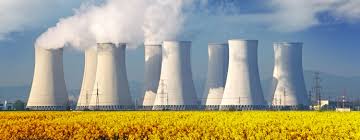Nuclear or atomic energy is the energy produced in thermonuclear plants, which use uranium and other elements, as fuel.
The operating principle of a nuclear power plant is the use of heat (thermo) to generate electricity. The heat comes from the fission of the uranium atoms.
Uranium is a non-renewable mineral resource found in nature, which is also used in the production of radioactive material for use in medicine.
In addition to its use for peaceful purposes, uranium can also be used in the production of weapons, such as the atomic bomb.
Nuclear Energy in the World

As a highly concentrated and high-yielding energy source, several countries use nuclear energy as an energy option. Nuclear plants already account for 16% of the electric energy produced in the world.
More than 90% of nuclear power plants are concentrated in the United States, Europe, Japan and Russia. In April 2018, the Russian government inaugurated the world’s first floating nuclear power plant, located in the Arctic Sea.
In some countries like Sweden, Finland and Belgium, nuclear energy already represents more than 40% of the total electricity produced. South Korea, China, India, Argentina and Mexico also have nuclear power plants.
Brazil has nuclear power plants on the coast of the state of Rio de Janeiro, in Angra dos Reis, (Angra 1 and Angra 2). The construction of the Angra 3 nuclear power plant, which had been paralyzed since 1986, had its environmental license approved in July 2008.
Advantages of Using Nuclear Energy
Despite the dangers, there are several positive points in nuclear power generation.
One of the first points to note is that the plant is not polluting during its normal operation and safety standards are met.
Likewise, a large area is not necessary for its construction. In comparison, just remember how much space a hydroelectric plant needs to make a dam and the size of the flooded terrain.
Also uranium is a relatively abundant material in nature that would ensure the supply of plants for long. The main reserves are in India, Australia and Kazakhstan.
Disadvantages of Using Nuclear Energy

However, the risks of using nuclear energy are immense.
In addition to its use for non-peaceful purposes, such as the production of atomic bombs , the waste generated by the production of this energy represents a danger to humanity.
There is also the risk of nuclear accidents and the problem of disposing of nuclear waste (waste made up of radioactive elements, generated in energy production processes). In addition, contamination of the environment that causes irreversible damage to health, such as cancer, leukemia, genetic deformities, etc.
Nuclear Accidents
Since the first accident, recorded in 1952 in Chalh River, Canada, many others have occurred. One of the most serious was the Chernobyl Accident , which occurred in Ukraine in 1986, which exploded due to a cooling system failure.
The most recent was in 2011 at the Fukushima 1 plant on Japan’s east coast, which was hit by the earthquake and tsunami that rocked the region. There was an explosion in the buildings that housed two reactors, which caused the release of radiation.
Brazil, too, faced the worst nuclear accident in its history when the Cesium-137 material was not disposed of properly. It is estimated that 1600 people were infected and 4 people died in this episode.

